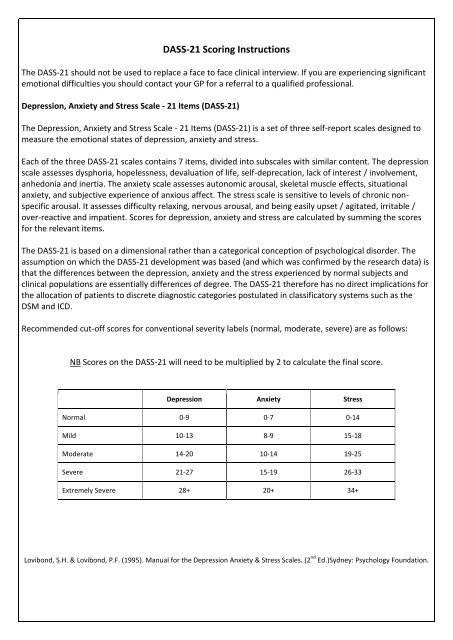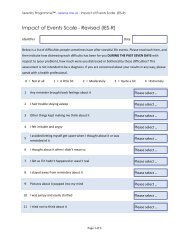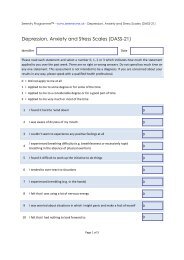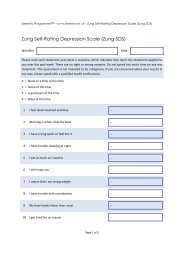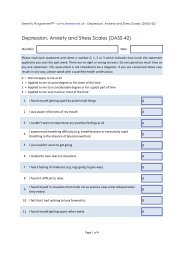DASS Scoring Instructions
DASS Scoring Instructions
DASS Scoring Instructions
You also want an ePaper? Increase the reach of your titles
YUMPU automatically turns print PDFs into web optimized ePapers that Google loves.
<strong>DASS</strong>-21 <strong>Scoring</strong> <strong>Instructions</strong><br />
The <strong>DASS</strong>-21 should not be used to replace a face to face clinical interview. If you are experiencing significant<br />
emotional difficulties you should contact your GP for a referral to a qualified professional.<br />
Depression, Anxiety and Stress Scale - 21 Items (<strong>DASS</strong>-21)<br />
The Depression, Anxiety and Stress Scale - 21 Items (<strong>DASS</strong>-21) is a set of three self-report scales designed to<br />
measure the emotional states of depression, anxiety and stress.<br />
Each of the three <strong>DASS</strong>-21 scales contains 7 items, divided into subscales with similar content. The depression<br />
scale assesses dysphoria, hopelessness, devaluation of life, self-deprecation, lack of interest / involvement,<br />
anhedonia and inertia. The anxiety scale assesses autonomic arousal, skeletal muscle effects, situational<br />
anxiety, and subjective experience of anxious affect. The stress scale is sensitive to levels of chronic nonspecific<br />
arousal. It assesses difficulty relaxing, nervous arousal, and being easily upset / agitated, irritable /<br />
over-reactive and impatient. Scores for depression, anxiety and stress are calculated by summing the scores<br />
for the relevant items.<br />
The <strong>DASS</strong>-21 is based on a dimensional rather than a categorical conception of psychological disorder. The<br />
assumption on which the <strong>DASS</strong>-21 development was based (and which was confirmed by the research data) is<br />
that the differences between the depression, anxiety and the stress experienced by normal subjects and<br />
clinical populations are essentially differences of degree. The <strong>DASS</strong>-21 therefore has no direct implications for<br />
the allocation of patients to discrete diagnostic categories postulated in classificatory systems such as the<br />
DSM and ICD.<br />
Recommended cut-off scores for conventional severity labels (normal, moderate, severe) are as follows:<br />
NB Scores on the <strong>DASS</strong>-21 will need to be multiplied by 2 to calculate the final score.<br />
Depression Anxiety Stress<br />
Normal 0-9 0-7 0-14<br />
Mild 10-13 8-9 15-18<br />
Moderate 14-20 10-14 19-25<br />
Severe 21-27 15-19 26-33<br />
Extremely Severe 28+ 20+ 34+<br />
Lovibond, S.H. & Lovibond, P.F. (1995). Manual for the Depression Anxiety & Stress Scales. (2 nd Ed.)Sydney: Psychology Foundation.


